Sphinx dollii
Neumoegen, 1881
Doll's Sphinx
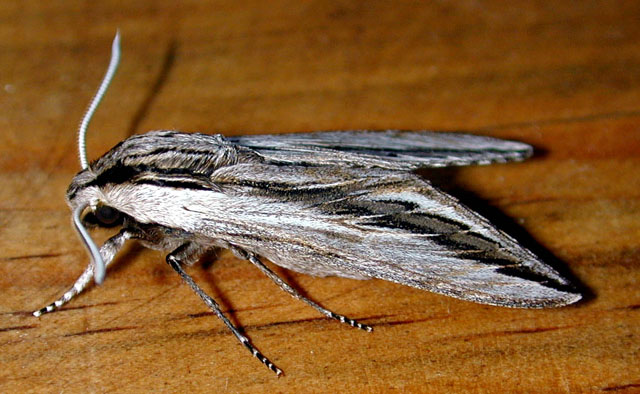
Sphinx dollii ( now S. vanbuskirki) male,
courtesy of Mike Van Buskirk.
Specimens on this page from Texas, are now, 2020, more properly classified as Sphin vanbuskirki, Haxaire, 2020.
Specimens of vanbuskirki seem to have a more pointed forewing tip.
This site has been created by Bill Oehlke.
Comments, suggestions and/or additional information are welcomed by Bill.
TAXONOMY:
Family: Sphingidae, Latreille, 1802
Subfamily: Sphinginae, Latreille, 1802
Tribe: Sphingini, Latreille, 1802
Genus: Sphinx Linnaeus, 1758 ...........
Species: dollii Neumoegen,1881
|
DISTRIBUTION:
The Doll's Sphinx Moth,
Sphinx dollii
(Wing span: 1 3/4 - 2 1/2 inches (4.5 - 6.3 cm)),
flies in arid brushlands and desert foothills from Nevada and
southern California east through Utah, Arizona,
Colorado, and New Mexico to Oklahoma and Texas. Arizona is the specimen type locality.
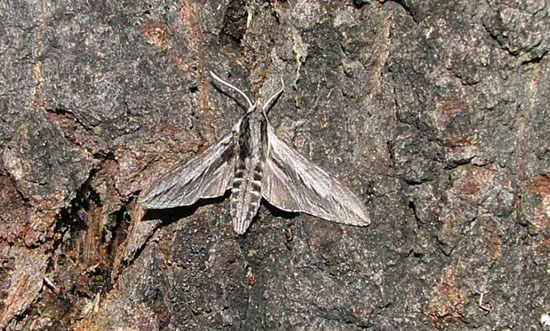
Sphinx dollii, Pena Blanca, Santa Cruz Co., Arizona,
August 6, 2004, courtesy of Bob Nuelle, Jr. and Robert Nuelle III
Sphinx dollii occurs in three forms:
1) in Yavapai County, Arizona the forewing is very pale gray and lacking most markings except black dashes along the
middle as per Paul Opler photograph top of page,
2) in the mountains of southern Arizona and southern New Mexico the forewing is bluish gray with well-defined heavy
black streaks along the middle as per Bruce Walsh photograph to the right and Mike Van Buskirk images,
and 3) in the remainder of the range, the forewing is gray with white streaks and a relatively well-defined row of dashes
along the middle. | 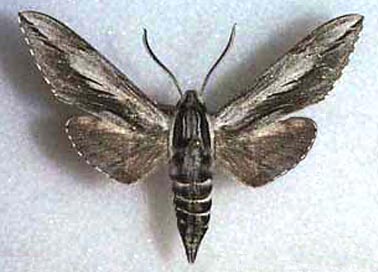
|

Sphinx dollii ( now S. vanbuskirki) male,
courtesy of Mike Van Buskirk.
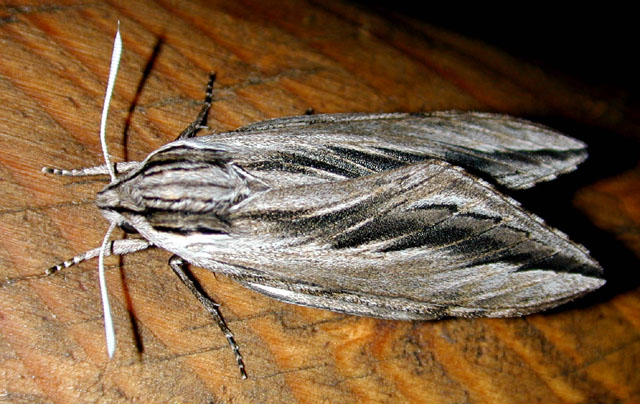
Sphinx dollii ( now S. vanbuskirki) female,
courtesy of Mike Van Buskirk.
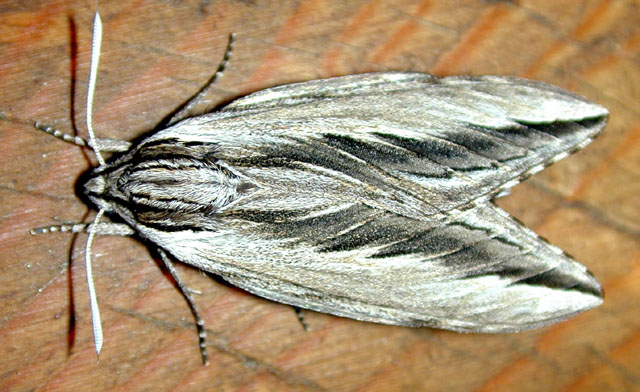
Sphinx dollii ( now S. vanbuskirki) female,
courtesy of Mike Van Buskirk.
FLIGHT TIMES:
Sphinx dollii adults fly as a single brood from June-August. Joel Szymczyk reports, "I've collected
them in Arizona in July/August, and here in NM in early June."
ECLOSION:
Pupae probably wiggle to surface from subterranean chambers just prior to eclosion.
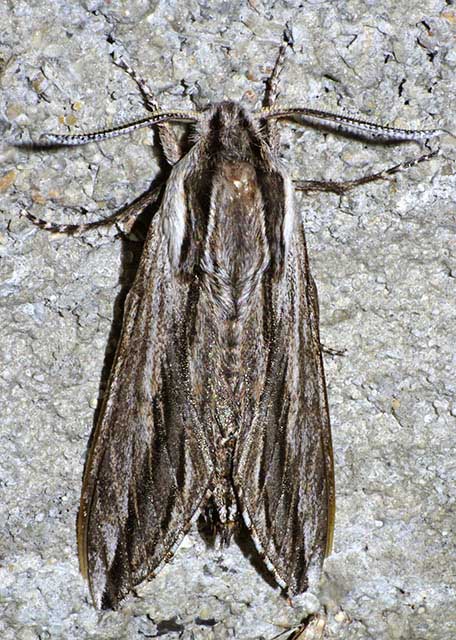
Sphinx dollii ( possibly S. vanbuskirki), Devil's River, Val Verde County, Texas,
May 18, 2019, courtesy of Dave Barker.
SCENTING AND MATING:
Females call in the males with a pheromone released from a gland at the tip of the abdomen. Adults probably nectar at a variety of
flowers.
A darker subspecies or form, Sphinx dollii australis, B.P. Clark, 1922, is recognized by some taxonomists. The moth is depicted in the
Bruce Walsh image to the right. | 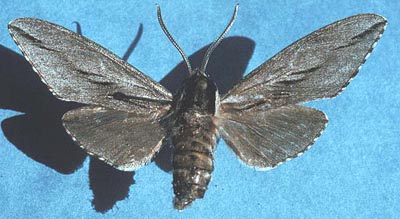 |
EGGS, LARVAE, PUPAE:
Larval hosts are Alligator juniper (Juniperus deppeana) and other juniper
species.
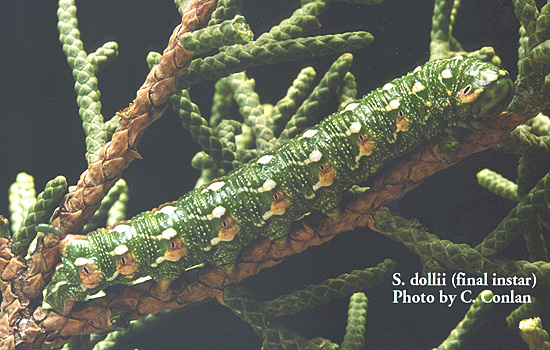
It is amazing to me how well the larval spiracular patches and false feet match the pattern and colour of the juniper bark.
I believe there is an active intelligence at work as opposed to a gradual evolution through "natural selection".
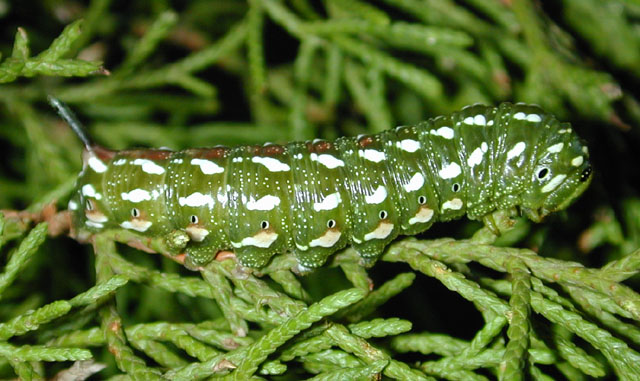
Sphinx dollii, ( now S. vanbuskirki) final instar, courtesy of Mike Van Buskirk.
Central Texas, Sphinx dollii 5th instar larva:
Ex-ovo from a captured female at my home light (May 10)
About 41 days old, hostplant is Juniperus ashei (Mountain Cedar)
Larvae feed day and night, and seem to like the humidity of the containers (large and tall refriferator containers)
First (2) larvae are pre-pupal today, slightly more red on dorsum Look fairly similar to S. dollii from Arizona.
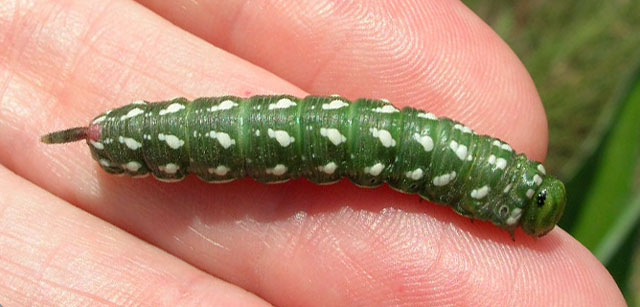
Sphinx dollii, just north of Austin, Texas, courtesy of David T. Anderson.
David writes, "I live in central Texas, just north of Austin. I would like some help here. Nobody seems to know what the name of
this Sphinx moth I found is. I picked up the caterpillar off my driveway. It looked like a dwarf Sphinx caterpillar. It turned into
a tiny Sphinx moth. It was just under an inch long. I've never seen one like this before. Do you know what it is?"
David's image of the Sphinx dollii larva gives a nice perspective on the size of this small Sphinx. The caterpillar had probably left
nearby foliage in search of some soft earth in which to pupate.
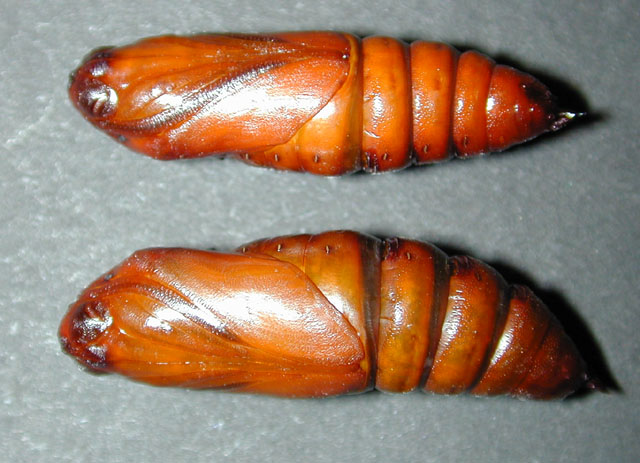
Sphinx dollii pupae, ( now S. vanbuskirki), courtesy of Mike Van Buskirk.
Mike writes, "The (13) Sphinx dollii pupae (pupated early July) are developing very quickly, as evidenced by
these pupal photographs. Larger pupa is female (bottom of pics), smaller is the male (upper on pics). Pupae were very quiet until
development started, and are now quite active. Note that even though this is a Sphinx-Genus pupa, there is no external tongue case."
Return to Sphingidae Index
Return to Sphingini Tribe












